
Archeological records show stones as old as around 2 million years being consciously shaped by early humans to use as tools and weapons. The stones were sharpened by rubbing against each other repeatedly to flake off the blunt sides into sharp edges. This rubbing of stones was what would lead humanity into the first giant leap into its future, the discovery of making fire. Once we knew how to make it, we learnt also to control it. By making fire, we broke the limitations of day and night, had a weapon against the predators and could cook the food outside our bodies releasing nutrients that until now were unavailable, transforming the way we lived, grew and evolved. Without fire, the world we live in today wouldn’t have been possible.
Human beings have changed a lot in a million years, but the skill that we have developed the most is that of interacting with our environment and learning to consciously modify it. All other living beings also modify their environments, but none can steer off the instinctual path embedded in their niche within the web of life like humans, and we have been pushing our physical and biological boundaries throughout our history.
This ability of human beings to project a thought, an idea from their minds and intentionally manifest it in the physical reality is what we have come to call Design. Interestingly, fire itself is a great metaphor to understand design, as explained by the great design philosopher, MP Ranjan[1]. Fire is a process of transformation, which is deeply connected to its fuel, the context. The transformation of the material also releases light and heat, which creates value for the community. Fire represents the foundations of the design process- the existence within a context, a vision for transformation, and the creation of value for the community (social and ecological).

Design has always been an integral part of human creativity that has shaped our individual and collective journeys. As humans discovered and developed the hidden potential within themselves and the world around them, they created an even more intimate relationship between their imagination and the matter. The most fascinating design applications can, therefore, be witnessed where the communities are deeply connected with their environments like the indigenous tribes and in villages where people have had to solve everyday challenges with their ingenuity and the resources at hand, treating every situation as an opportunity to transcend material and spiritual boundaries to manifest objects and ideas of value. Fascinatingly, in such contexts, Design has always been and continues to be simply a way of life.
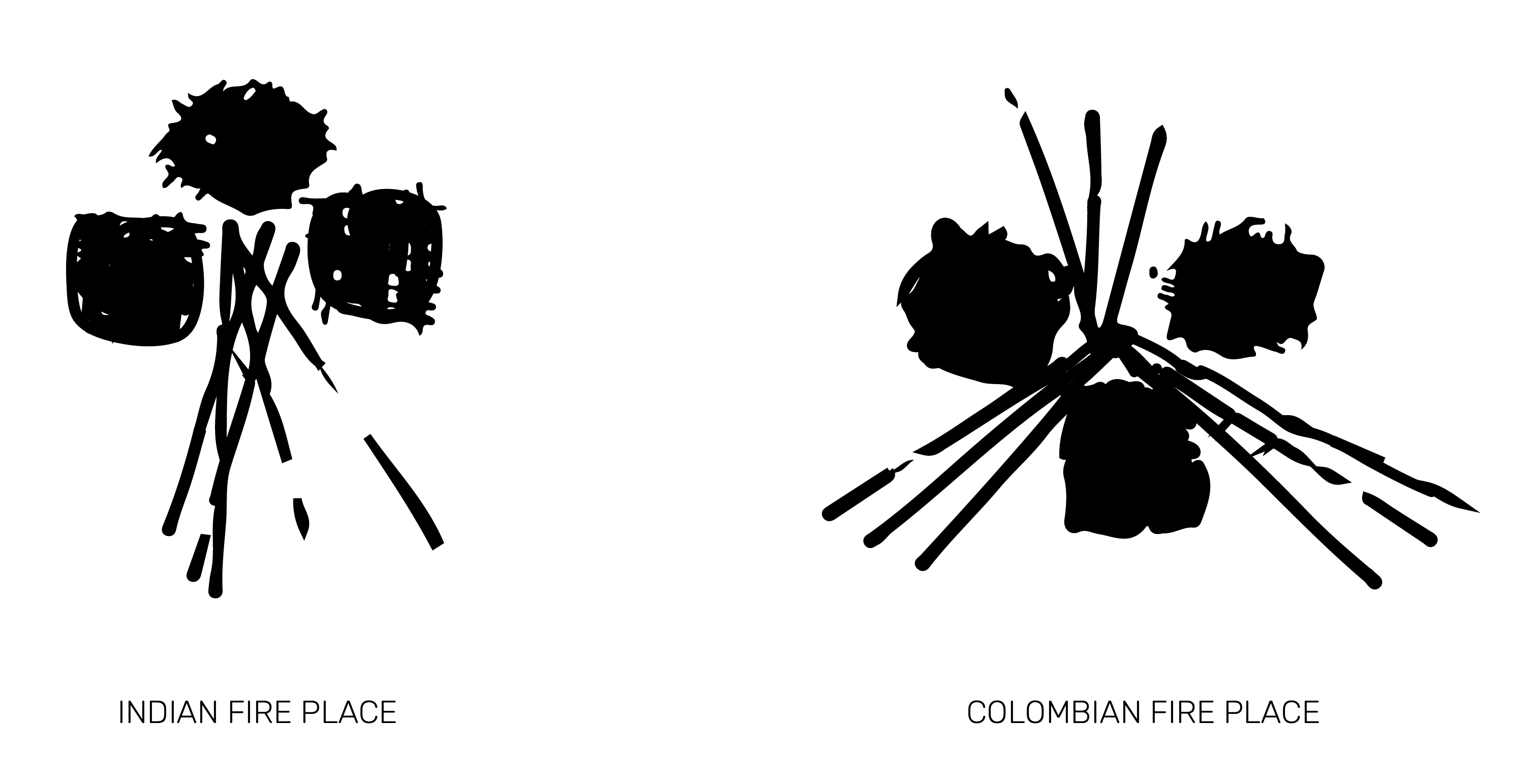
Different ways of arranging stones for making fire for cooking
This ability to create, learn and evolve has helped us develop culture and agriculture over thousands of years, and more recently the research and applications of science and technology. These changing ecological and social relationships have in turn changed the way we look at and use design.
As human life continues to grow more and more complex, many people have tried to articulate what Design is and how it can help us respond better to the rapidly changing world around us keeping in mind our past and the future. In the1950s, pioneers like Buckminster Fuller were using Design as a scientific approach to solving systemic problems by creating teams of experts from different disciplines. Though Fuller’s work broke many paradigms, it projected Design as an elite field of work accessible only to experts. At the same time in the 1960s, researchers and designers were experimenting with new models of facilitated design groups with the community to come up with problems on governance etc. This approach came to be known as the Scandinavian approach and formed the foundations for participatory design. The popularity of Design continued to grow through the 1970s as a new way of looking at “wicked problems”[2] or problems that force us to think “out of the box”, stepping out of our notions of linearity, of black and white and often arriving at extremely simple solutions for seemingly complicated challenges. Design became Design Thinking in an attempt to create a method of design, distilling the abstract intuitive practice into a scientific process that can be applied in different contexts of business and geography.
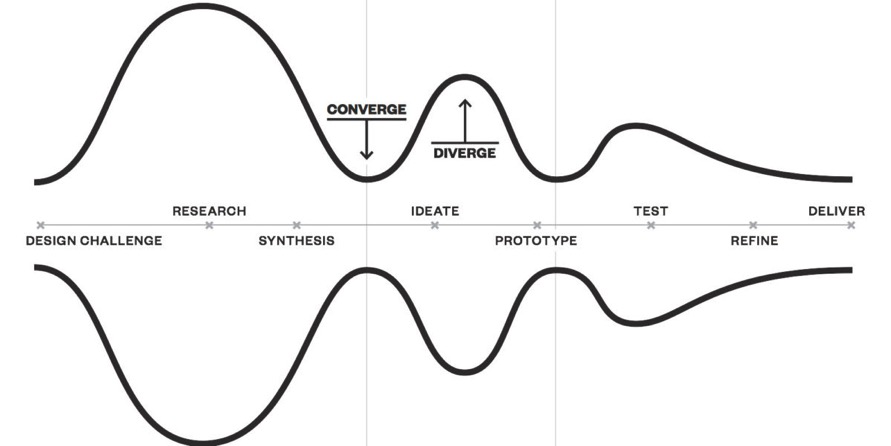
An illustration of the Design Thinking process from IDEO [3]
In the 1990s, as technology began to skyrocket, design thinking became more and more sought after as an approach to solving human problems through technology. Technological solutions became the panacea for a better future and led to the birth of Human Centered Design. Human Centered Design is based on designing for the user, by extensive research into user behavior and needs. Human Centered Design Thinking allowed the designers to create an ethical framework within which one could look for the problems and their solutions and thus create a healthy boundary for technology for it to serve human communities and environment. Designing for the user also meant designing with the user. Interaction Design and Service Design thus developed as the next big ideas in Design. This participatory approach of Design Thinking also allowed for its application in social contexts especially for education in schools and communities. With this, Design graduated to Social Design [4] and became popular alongside other social and community theories and methods like Social Permaculture that developed and grew during the 1990s.
“Design must be an innovative, highly creative, cross-disciplinary tool responsive to the needs of men. It must be more research-oriented, and we must stop defiling the earth itself with poorly-designed objects and structures.”[5]
– Victor Papanek
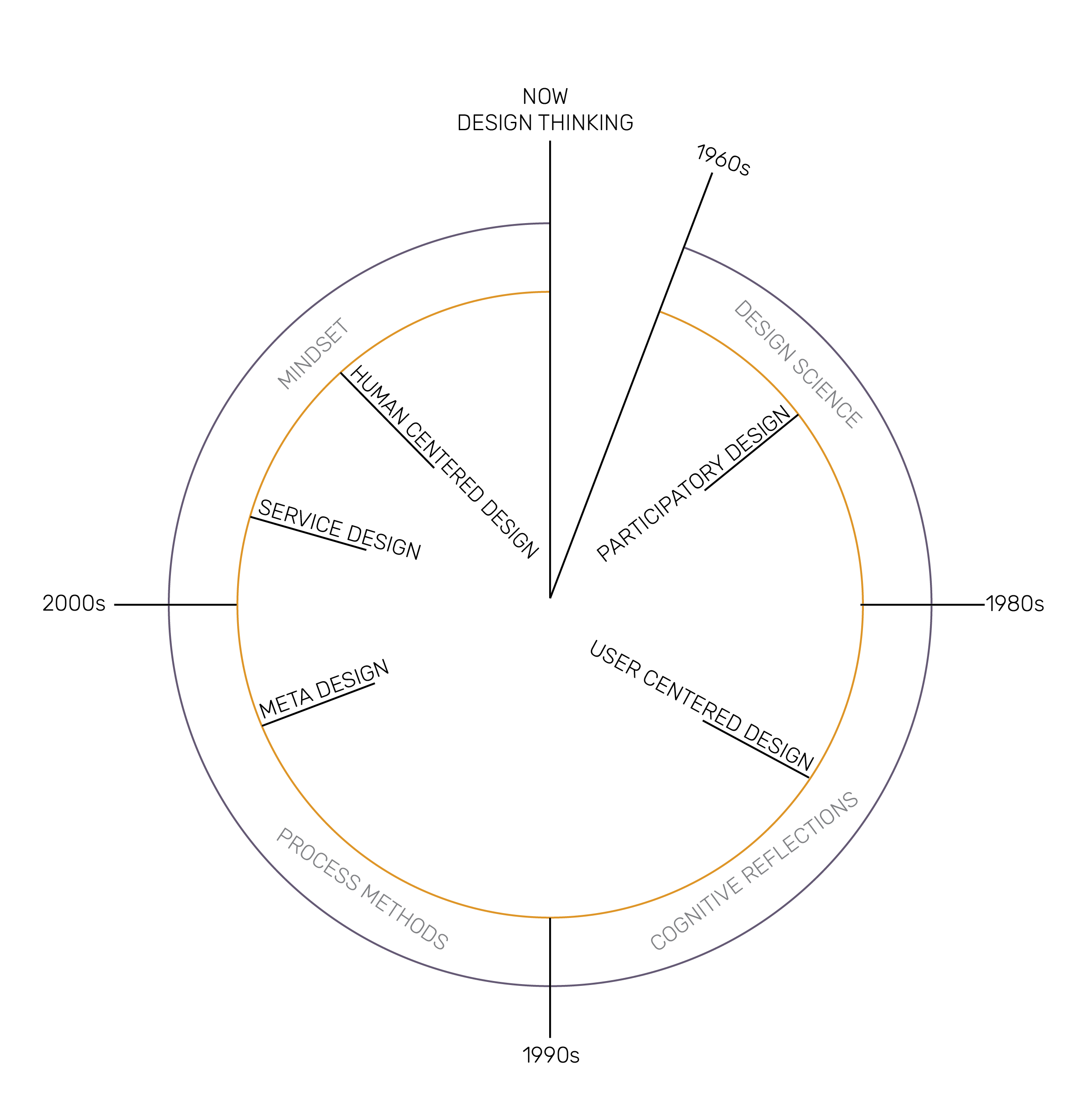
Development of the Design Thinking method by Stefanie Di Russo [6] & [7]
However, even though Design as a discipline continued to get enriched with ideas and experiences, it became more and more specialized and distanced the designer and the user. The specialized technology involved in most of our modern world ecosystem also created a gap between the relationships we have with our immediate environment. We just don’t understand it enough and thus our interaction with it is limited, only to the extent to which it is meant to be.
Although Design today seems to be a complex process, it has fundamentally remained what it perhaps was when we first started making tools from stones a couple of million years ago. The only difference seems to be the approach to design, which has shifted from paradigms of being, to paradigms of knowing to predominantly paradigms of doing.
Design is intrinsically democratic and non-specialised because it springs forth from the experience of observing relationships within one´s context. Human beings are born with and create during their lives, multiple relationships with other people and their environment. Besides the relationships with the world outside, we are also related to ourselves with the world inside. A healthy community sustains itself on its relationships with self, others and the ecology, and the design of its future needs to be based on these relationships.
As human understanding of the interconnectedness of life, human society and individual worlds deepens, Design can help us protract our observation and thinking lending us the canvas to project into the future within and beyond our lifetimes and look at human actions and interventions as the first of a long chain of interactions continuing over large scales of geography and generations. In this future, designing for the user or just for humans will not be enough. As our ecological paradigms shift human position from the top of the pyramid to a part in the web of life, we need our design philosophies and values to reflect the realization that humans are not the centers of this universe. This new Design is now being called Life-centered Design[8].
So, we have come a full circle in recognizing that any human action has its impact on the world much beyond her/him and that considering the principles of life when designing and using new technologies and products is at the foundation of any sustainable, even regenerative future. And this is more important than ever because of the rapidly globalizing world and the immense impact of technology on all aspects of our life. This leads us to Systems Thinking and Systems Design, a field of human study that studies the vast networks of relationships in an abstract and physical ecosystem. The design solutions developed from these approaches tend to be guided by the patterns of such a system to be able to synchronize with the principles on which the system works.
For a meaningful Life-centered Design or simply Design, as it should be, it will then be worthwhile to investigate the patterns of life itself to come up with solutions that can be sustainable within that framework. One of the inherent principles of life is that it is constantly changing, building and destroying itself, reorganizing and recombining to become anew all the time. We have come to understand these complicated processes as evolution, a pattern of movement towards more and more complexity and harmony that is common to all life forms individually and collectively.
The evolution of ecosystems has been studied since the mid 18th century by naturalists like Henry David Thoreau and Henry Gleason. Recently, Ernst Gotsch[9] has applied these principles to farming and inspired a new movement in Agroecology and Successional Agroforestry. By following these patterns of natural succession it is possible to create functional ecosystems in a much shorter time span that would happen naturally. Forestry projects around the globe recognize these evolutionary cycles and their potential in regeneration and are planning and executing afforestation projects accordingly.
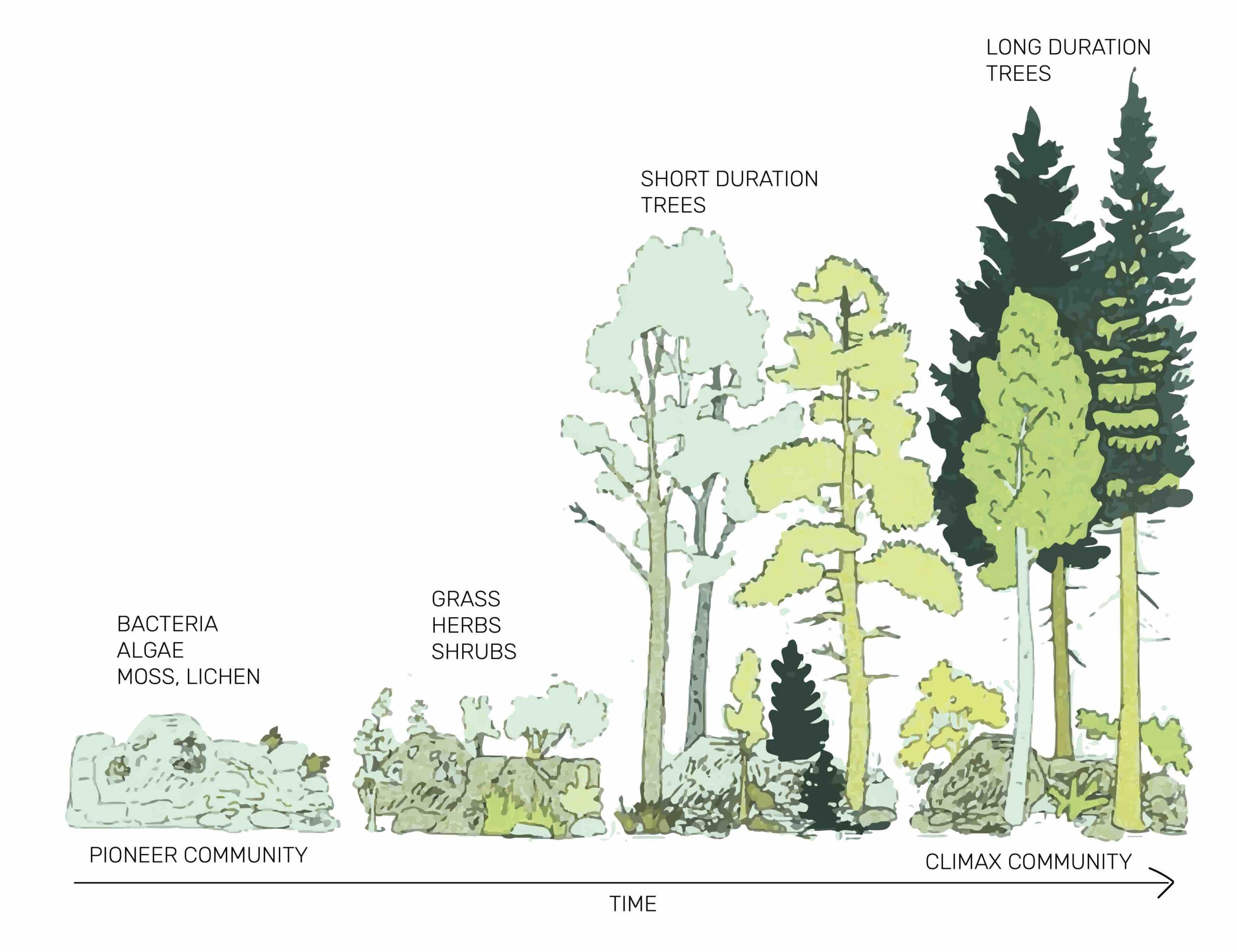
A typical succession of vegetation in an ecosystem
On a social scale, Karl Marx articulated, in the mid-18th century, the progression of human organization structures from primitive societies to feudalism to capitalism to socialism finally to communism as an expression of refinement of the ideals of human society. Though many people would disagree with the suggestions of Marx and the frameworks of the finality of a communist society, the idea of evolution within human communities is both interesting and worth considering. According to Mirra Alfasa, the spiritual leader who laid the foundations of Auroville in 1968, the culmination of human struggles towards the perfect organisation will be in a structure she called “Divine Anarchy”, where human beings are organized and guided by their higher selves beyond dogmas of a particular ideology or system. This brings the responsibility of the future back to us. It can be whatever we want it to be, or perhaps whatever it is meant to be.

Constantino Apostulou Doxiadis, the Greek Architect observed the same pattern of evolution in human settlements and described it in his seminal works on the science of Ekistics[10] in the 1960s. The insights of these patterns continue to guide city planners even today in an attempt to create the perfect city.
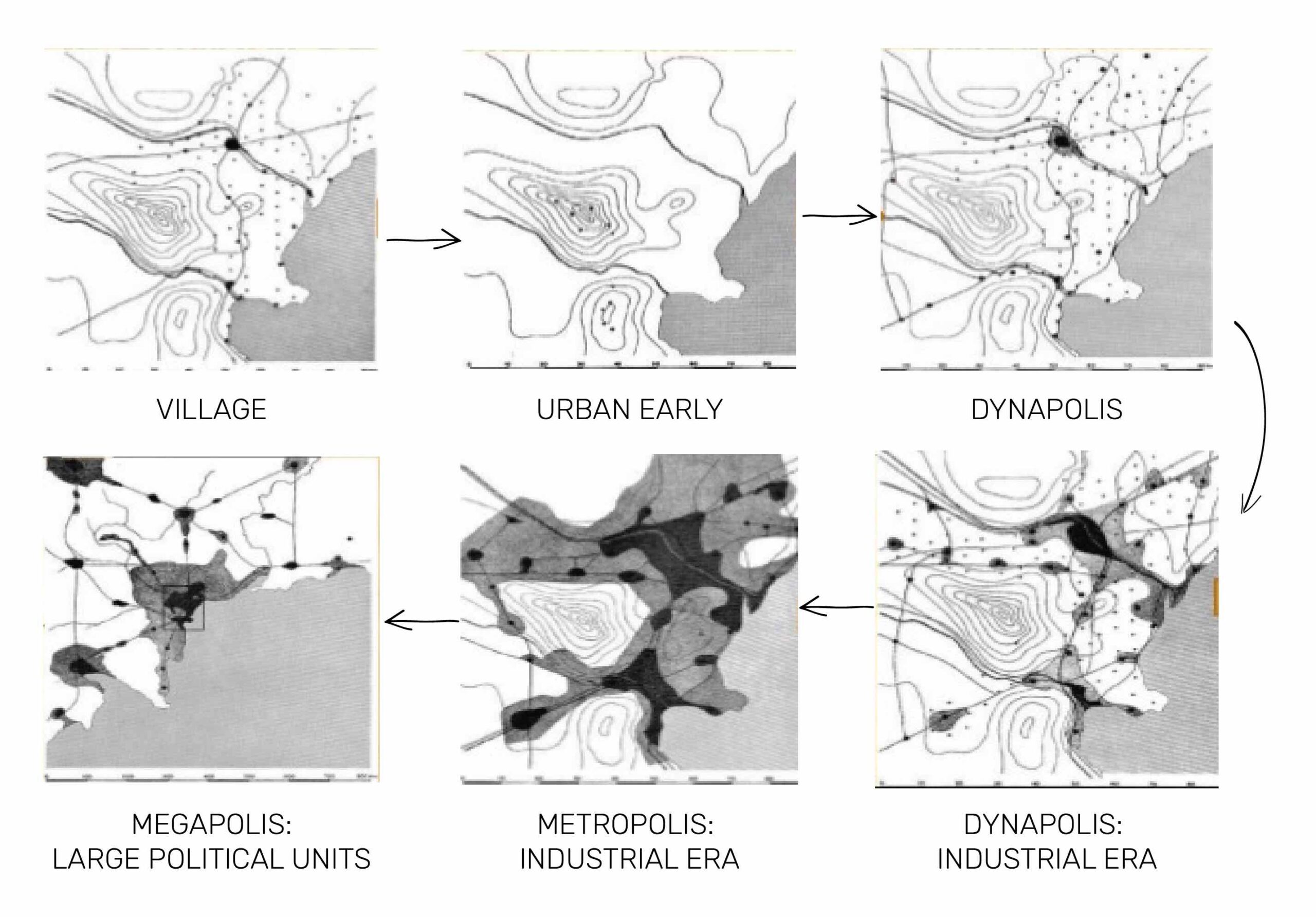
The evolution of human settlements according to Doxiadis’s Ekistics
An then, each individual also follows the same evolutionary pattern physically and spiritually. Mystic traditions of all religions have talked about levels of consciousness that human beings go through in a single birth or through several births. Seers from different religious and mystical practices have outlined the goal of human consciousness and the various paths that lead to it based on their own experiences and realizations. The philosophy and practices of Yoga are one such system of working on this evolutionary principle of human soul and moving through the stages consciously and within a shorter time span.
“Yoga is a rapid concentrated conscious evolution of the being, which may effect in a single life what in an unassisted Nature might take centuries and millenniums or many hundreds of lives.”
-Sri Aurobindo
[The Synthesis of Yoga – I: The Supermind and the Yoga of Works]

“Man is at the bottom, divine at the top. The wavy line is the path of the ordinary life, the straight line the path of yoga”
-Mirra Alfasa
This knowledge of patterns can allow us to work our way towards a healthier future. Not only can we make better choices, we can accelerate evolution and succession by participating in these natural processes. Our technological feats in the last three decades have already catapulted humanity into a reality that was a distant dream once and as we unravel the potential of a truly global community, design can help us more than just to come up with solutions, it can help us redefine the problems and move towards a collectively desired future consistently and rapidly. This is the beauty of design.
“When wireless is perfectly applied the whole earth will be converted into a huge brain, which in fact it is, all things being particles of a real and rhythmic whole. We shall be able to communicate with one another instantly, irrespective of distance. Not only this but through television and telephony we shall see and hear one another as perfectly as though we were face to face, despite intervening distances of thousands of miles; and the instruments through which we shall be able to do this will be amazingly simple compared with our present telephone. A man will be able to carry one in his vest pocket.”
-Nikola Tesla in 1926
With the emphasis on externalization of human life, we are losing the skills of intuition and cultivation of the deep sense of self and place, which in turn nurture creativity and design. The world of tomorrow doesn’t depend on a single technological idea or a unique design solution; it depends on the ability of each individual to participate in dreaming and building of this new world. To learn and share this skill we only have to look within ourselves and invoke our intuition to guide us.
The new paradigms in education [11] are already looking back into the past and re -establishing the connections that we have lost with our surroundings and ourselves. To empower ourselves and the new generations to design better, our education paradigms have to focus on how we can observe and learn better. The speed of the modern world doesn’t allow us to appreciate the nuances and the subtleties. It is on the edges of the obvious and the visible that answers to some of the most complicated problems of humanity lie and are waiting to be discovered. Slowing down to ask questions, listening and reflecting could help create solid foundations for imagination to take off from. This will require a shift in our priorities, a cognizance of what is essential and important to create a design approach based on ethics and values to honor and uphold relationships. Recognizing and articulating these ethics is also a very important part of the process of design.
This paradigm of education will be a paradigm of learning about ourselves, our communities and our environment, an opportunity for educators and students to discover the invisible and bring design back to life by bringing life back into design.
—
REFERENCES
[1] design-for-india.blogspot.com/search/label/Design%20Thinking
[2] www.jstor.org/stable/1511637?origin=JSTOR-pdf&seq=1
[4] pure.tue.nl/ws/portalfiles/portal/41867354/chensoci2016.pdf
[5] monoskop.org/images/c/c2/Papanek_Victor_Design_for_the_Real_World_2nd_ed.pdf
[7] academia.edu/24919250/Understanding_the_behaviour_of_design_thinking_in_complex_environments
[8] omny.fm/shows/this-is-hcd-human-centered-design-podcast/ep34-john-thackara
[9] agrofloresta.net/static/artigos/break-through-in-agriculture-ernst_goetsch.pdf
[10] www.doxiadis.org/Downloads/ecistics_the_science_of_human_settlements.pdf
